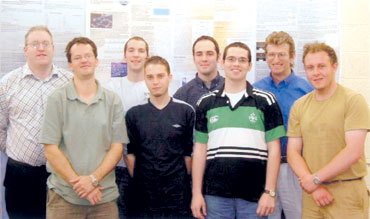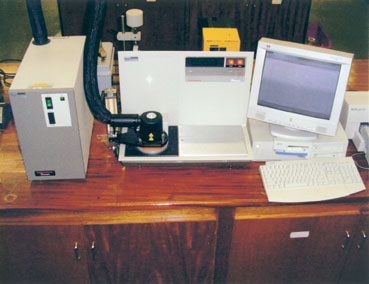| 2004 |

|
YEAR BOOK |
Athlone Institute of Technology
|
Biomedical polymer research at AIT
|

|

|

|

The primary research examines structures, properties and applications for biomedical polymers. These applications include coatings for intrusive medical devices, drug delivery systems, and novel biodegradable implants. The research is both applied research, carried out in conjunction with industry, and pure research on novel aspects of polymer systems.
An area of huge importance is the 'smart' polymer. A smart polymer is a material that can respond to a stimulus, such as a change in temperature or a change in pH. Under certain conditions, a polymer can either shrink or expand, depending on its environment, and this is possible because they behave in a similar fashion to a sponge. The polymer absorbs water while still maintaining structure, and the amount of water that is absorbed will be different under varying conditions.
Researchers in the biomedical polymer research group at AIT are finding that, by altering the polymer structure, they can control when and how the materials respond. Typical applications for such polymers would be:
-
Artificial muscles, where the contraction and swelling mimic biological muscle.
-
Medical diagnosis and treatment, whereby systems could be tailored to respond to specific signals from affected sites.
-
Protein biotechnology, where cell cultures could be easily decoupled from cell frame works by applying an external signal.
Other applications of these special polymers are in cases where there is a change in pH in the body caused by disease. Using pH sensitive polymers, drugs may be released in response to this change in pH.
The research in AIT is at the forefront of polymer science in Ireland, and the understanding and methodology developed is helping to contribute internationally to the science of biomedical polymers.

-
Development of temperature sensitive and pH sensitive complexes of polyvinyl pyrrolidinone-polyacrylic acid.
-
Development of polylactide and polycaprolactone blends for tissue engineering applications.
-
Investigation of physical cross linking in polyacrylic acid and polyvinyl alcohol polymer systems for biomedical applications.
-
Development of novel biodegradable drug delivery systems using electrically stimulated responsive polymer.
-
Synthesis and characterisation of drug-eluting coatings for medical devices.
References
Declan M. Devine & Clement L. Higginbotham, The Synthesis of a Physically Crosslinked NVP Based hydrogel, Polymer, 44, 2003, 7851-7860.
Declan M. Devine, Luke Geever, Michael J. D. Nugent & Clement L. Higginbotham, Synthesis, Characterisation and Swelling Studies of a Temperature Sensitive NVP Based Copolymer for Drug Delivery Applications, Institute of Materials, Minerals and Mining, Materials Congress 2004.
Contact: Dr Clement L. Higginbotham; E-mail: [email protected] ;
Michael Nugent; E-mail: [email protected] ; Polymer Department (CBBR),
Athlone Institute of Technology, Dublin Road, Athlone, Co. Westmeath; Tel: 353 (0) 90 6424400